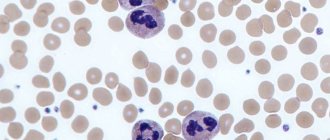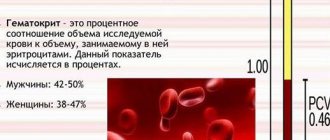Why might neutrophils be low?
Low blood levels are characteristic of some diseases and conditions:
- infections of viral origin (chickenpox, hepatitis, influenza);
- inflammatory processes;
- radiation sickness;
- taking certain medications (usually cytostatics or immunosuppressants in the treatment of autoimmune diseases or malignant tumors, as well as antimicrobials - penicillin, cephalosporin, sulfonamide);
- chemotherapy for cancer;
- agranulocytosis;
- anemia (aplastic and hypoplastic);
- exposure to radiation.
Reasons for decreased neutrophils and increased lymphocytes
The main reason for the increase in lymphocytes and decrease in neutrophils in the blood test should be considered infections.
They can be caused by viruses or bacteria. Often such an analysis can be obtained at the incubation stage, that is, when there are no symptoms of the disease yet, but the microbe has already entered the body, and the immune system has begun to fight it. Few neutrophils can also be observed during an allergic reaction. Based on these indicators, allergists can accurately tell whether a person has a tendency to be allergic, for example, to poplar fluff in the spring or to pollen. The patient himself may not be aware that he has a high risk of developing an allergic reaction.
A lot of lymphocytes in the blood often indicates an acute course of the disease. This can be either influenza or acute respiratory viral infection, or tuberculosis, systemic lupus erythematosus, lymphogranulomatosis, or kidney disease.
And finally, such a blood test can be obtained in the event of the development of an abscess, phlegmon, abscess, gangrene, heart attack or stroke. Therefore, to make an accurate diagnosis, the number of neutrophils and lymphocytes in the blood alone will not be enough.
Why do lymphocytes increase?
Lymphocytes are considered the main immune cells. They produce antibodies against foreign microorganisms and form humoral immunity. They make up about 25-40% of all leukocytes. Their increase in the blood occurs in the following cases:
- for viral diseases;
- for tuberculosis;
- for acute and chronic lymphocytic leukemia;
- with lymphosarcoma;
- with hyperthyroidism.
An increased level of these cells is said if their absolute number exceeds 3.6x109 per liter. Neutrophils in the blood in such pathologies may be reduced.
What are neutrophils?
Neutrophil granulocytes are blood cells produced in the human red bone marrow. Their main purpose is to protect against infection. They can live for several hours or days, depending on whether there is a focus of inflammation in any system of the human body.
As a rule, the content of these bodies in an adult should fluctuate between 47% and 72% of the total number of leukocytes. As the child grows older, their concentration gradually increases, given that their number will still be at approximately the same level.
The percentage of this type of leukocyte in a child who is about a year old will be from 30% to 50%. At seven years old, this ratio increases slightly and is 35%-55%, and in adolescence it will vary from 40% to 60%.
If the analysis showed an increased concentration of these cells in a person, this indicates neutrophilia. The increase factor is usually considered to be the development of the inflammatory process. Depending on the percentage of increase in these cells during inflammation, you can determine its approximate extent and how actively the body itself counteracts it.
Causes of increased lymphocytes and decreased neutrophils
The leukocyte formula has a more important diagnostic value, since most often changes occur in it, while the total number of leukocytes does not change. Thus, during viral infections, the absolute level of leukocytes in the blood remains within normal limits or is slightly increased, while in the leukogram, lymphocytes are increased and neutrophils are decreased. As mentioned above, this occurs mainly with viral infections, malignant tumor diseases, exposure to radiation, and after taking certain medications. Such changes in the leukogram indicate that the body is fighting the disease.
This is what lymphocytosis looks like in the blood under a microscope
A decrease in granulocytes with increased lymphocytes can be observed if a person has recently suffered from acute respiratory viral infection or influenza. As a rule, blood counts do not return to normal immediately, but some time after recovery. Thus, neutropenia against the background of lymphocytosis indicates that the infection is subsiding and recovery is occurring.
It should be said that increased lymphocytes and decreased neutrophils are a normal condition for children. The fact is that the norms for adults are different. Thus, the number of neutrophils in children is less than in adults, and in different years of life ranges from 30 to 60%, in adults this figure is 45-72%. On the contrary, there are more lymphocytes in children than in adults - 40-65%.
Characteristics of analyzes
Neutrophils are determined according to certain standard standards. The discrepancy characterizes the high activity of blood cells and signals the onset of pathological processes. The presence of mature and immature neutrophilic granulocytes is studied. There is no dependence on gender; it is determined by age category.
In adults, band neutrophils should not exceed the level of 1-4, segmented neutrophils - from 40 to 60. Important indicators include the ratio in percentage and numbers.
An increased level of lymphocytes indicates the onset of inflammation in the body. The doctor determines the location of the disease by analyzing accompanying manifestations. Lymphocytosis in acute pathology is characterized by an increase in neutrophils, observed in the formation of:
- Internal inflammation with the appearance of purulent content - sepsis, peritonitis, tonsillitis and cholera, scarlet fever, pyelonephritis.
- Processes of a necrotic nature - stroke, frostbite, gangrene or large-area burns.
- Lead or alcohol intoxication.
- Oncological neoplasm.
A formula is used to determine the white cell ratio in a blood test. Leukocyte count allows you to calculate the number of leukocytes per 100 cells. The crossover is observed in childhood, when immune barriers are lowered.
Decreased neutrophils with increased lymphocytes are the norm in a child. The cause is vaccination. The immune system reacts to the vaccine as if it were a foreign body, the process of producing antibodies starts, but the granulocytes do not react due to the incapacitated microorganism.
- Why are neutrophils elevated in an adult, what does this mean, what to do?
Few neutrophils and many lymphocytes in an adult are characterized by the following pathologies:
- the body is exhausted;
- typhus, brucellosis;
- infection with bacteria that led to the death of granulocytes;
- blood diseases;
- treatment with chemotherapy, radiation therapy.
Such indicators are typical for the body’s fight against the disease, after the pathogen has been eliminated. Gradually, deviations from the norm will disappear in the analyzes.
Interpretation of analyzes
When deciphering a blood test, all indicators are assessed together. When diagnosing, special attention is paid to the leukocyte formula, which reflects the ratio of all types of white blood cells. In diseases, the content of some leukocytes may change due to an increase or decrease in others. Using the leukocyte formula, one can judge the development of complications, how the pathological process proceeds, and also predict the outcome of the disease.
According to leukogram data, it is possible to distinguish a viral disease from an infectious one. With a viral infection, the total number of all leukocytes does not change or is slightly increased, but there are changes in the leukocyte formula: lymphocytes are increased, neutrophils are decreased. At the same time, ESR (erythrocyte sedimentation rate) increases slightly, with the exception of acute pronounced processes of viral origin. As for bacterial damage, the level of leukocytes increases due to the growth of granulocytes, the relative content of lymphocytes decreases. ESR during bacterial infections reaches very high values.
Indicators of two forms of neutrophils
When a neutrophil develops in the red bone marrow, it forms into a band.
It enters the plasma in certain quantities and after a certain period of time is divided into segments. So it becomes segmented, that is, fully formed, and after a few hours it penetrates the membranes of the capillaries of various organs. It is in those areas that it resists foreign agents. The concentration of segmented cells is written as a percentage in the leukocyte formula. With its help, it is possible to assess the condition of the blood, and therefore the body. However, before this, the norm of these cells in the blood should be determined. As already mentioned, in an adult healthy person the norm of segmented bodies ranges from 47% to 72%, and in band bodies it corresponds to 1–5%.
The analysis can also show changes in the leukocyte formula. Typically, two shifts are specified, either left or right. A shift of the formula to the left indicates the presence of bodies that are not yet fully formed, which, in accordance with the norm, should be exclusively in the bone marrow, but not in the blood. And a shift of the formula to the right means that the content of segmented cells is increased, and the number of nuclear segments becomes more than five.
Therefore, when deciphering a clinical analysis, it is necessary to pay close attention to the indicators of both forms, since deviations can warn of serious changes in the body.
If you promptly see the discrepancy between these bodies and the required number, there is a chance of avoiding many of the ensuing consequences that are associated with the development of the inflammatory process.
Basis for increasing lymphocytes
An increase in lymphocytes is called lymphocytosis. It can also be physiological or pathological. In the first case, the basis for the increase should be considered hard physical work and menstruation in women.
Pathological lymphocytosis is observed in all infections, both in childhood (chickenpox, chicken pox, whooping cough) and in adults (influenza, ARVI). Other reasons for increased lymphocytes in the blood include:
- Infectious mononucleosis.
- Cytomegalovirus infection.
- Transition from acute to chronic disease.
- The stage of inflammation subsiding.
- Bacterial infections.
- Autoimmune diseases.
- Acute immediate allergic reaction (anaphylaxis).
- Malignant and benign tumors.
Severe lymphocytosis is characteristic of chronic lymphocytic leukemia and Waldenström macroglobulinemia.
- Neutrophils are reduced in an adult. Causes of lymphocytes increased, decreased in the analysis
Lymphocytosis is usually divided into relative and absolute.
Relative lymphocytosis occurs when lymphocytes remain normal, but displace neutrophils and their percentage is reduced to the minimum possible. This happens with diseases of the joints of a rheumatic nature, with increased levels of thyroid hormones or with an increase in the size of the spleen (splenomegaly).
Absolute lymphocytosis is an increase in the number of lymphocytes at other norms. This occurs with toxoplasmosis, viral pneumonia, tuberculosis, syphilis, brucellosis and diphtheria.










